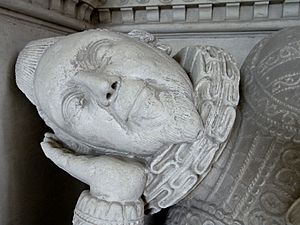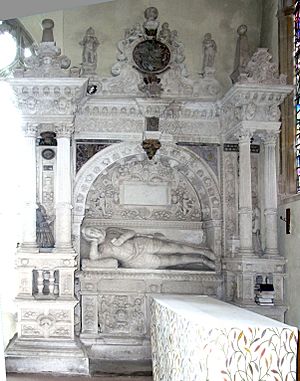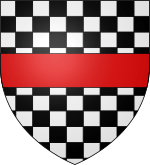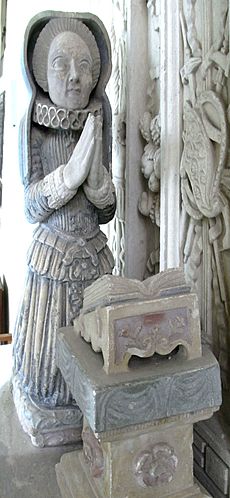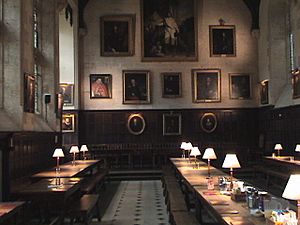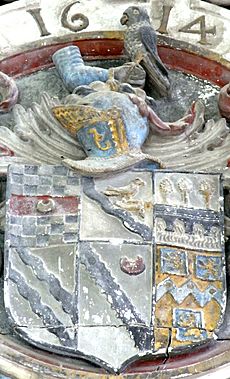John Acland (died 1620) facts for kids
Sir John Acland (around 1552 – 1620) lived in a place called Columb John in Broadclyst, Devon. He was an important English knight, a big landowner, and someone who loved to help others (a philanthropist). He also served as a Member of Parliament and was the Sheriff of Devon. People like John Prince thought he was one of the "Worthies of Devon," meaning a very important person from the area.
Contents
Who Was Sir John Acland?
Sir John Acland was the second son of John Acland (who died in 1553). His mother was Mary Redcliff. She owned land near London and made John her heir. His older brother, Hugh Acland, inherited the family's main home in Acland.
Sir John's Career
Sir John Acland was a busy man!
- In 1583, he became a Justice of the Peace. This meant he helped keep law and order in his local area.
- From 1608 to 1609, he was the Sheriff of Devon. The Sheriff was a very important official, like a chief law enforcement officer for the county.
- He was elected as a Member of Parliament for Saltash in 1586. This meant he helped make laws for the country.
- King James I made him a knight on March 15, 1604, at the Tower of London.
- Later, in 1607, he became a Member of Parliament for Devon.
Sir John's Marriages
Sir John Acland married twice, but he didn't have any children who lived to adulthood.
- His first wife was Elizabeth Rolle. She came from a very wealthy family. Elizabeth was also a widow. Her wealth likely helped Sir John buy the large estate of Columb John. On his monument in Broadclyst Church, there's a statue of Elizabeth kneeling. They had one daughter, Dorothy, but she sadly died as a baby.
- After Elizabeth passed away, Sir John married Margaret Portman. She was another very rich widow. This marriage also had no children. On his monument, there's also a statue of Margaret kneeling.
Lands and Homes
Sir John bought the estate of Columb John in Broadclyst. It was about 32 miles from his family's original home. He rebuilt the old manor house there. He also set aside money every year to pay a chaplain. This chaplain would preach and lead prayers in the house's chapel every Sunday.
The nearby estate of Killerton was bought by Sir John's nephew, Sir Arthur Acland. Killerton later became the main home for the Acland family. The famous Killerton House that stands today was built by his descendants.
Death and Burial
Sir John Acland died on February 14, 1620. He was buried in Broad Clyst church. He had actually ordered his own monument to be built there in 1613. Since he had no children, his older brother, Hugh Acland, became his heir.
Helping Others (Philanthropy)
Sir John Acland was known for his many generous gifts.
- He gave money to the mayor and city council of Exeter. This money was used to help the poor people in Exeter and other parts of Devon.
- He helped pay for a new dining hall at Exeter College, Oxford. He gave about £800, which was a huge amount of money back then! He also set up two scholarships at the college to help students.
- He gave money to buy bread for the poor in 27 different parishes where he owned land. There's even an old poem about him in Pilton Church:
Here Sr John Acland to the poor's a friend,
In giving bread noe times to have an end,
Sixpence a week by him to us is measured,
A crown for him in Heaven's laid up and treasured
Sir John's Monument
Sir John Acland's monument in Broadclyst Church is very grand. It's considered one of the most beautiful monuments from the Jacobean period in Devon. Sir John himself ordered it to be built.
- It shows him lying down in full armor, resting on his right elbow.
- His two wives are shown kneeling in prayer at his head and feet.
- The monument has columns, fancy decorations, and little angel figures.
- It has Latin phrases like:
- Mors janua vitae (Death is the gateway to life)
- Mors mihi lucrum (Death to me is a reward)
- Post tenebras spero lucem (After darkness I hope for light)
- Caro mea requiescit in spe (May my flesh rest in hope)
- A Deo omnis victoria (All victory comes from God)


